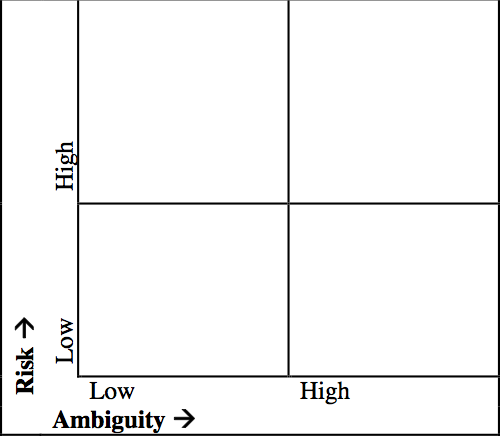
Ambiguity, or doubtfulness and uncertainty, is something we often try to remove from school. The most interesting things in life and in science, however, are ambiguous. Walter Doyle discussed the relationships between risk and ambiguity in educational settings and in settings outside of the formal educational system (1986).
Consider the figure below (adapted from Doyle’s work) to plot out different classes you’ve taken and to plot out challenges individuals face outside of the educational system. At some colleges, biochemistry could be described as high risk and low ambiguity. If you know what you have to do is memorize many, many chemical structures to be successful, there is little ambiguity. If success in the course determines whether or not you get into medical school, there is high risk. Some academic work, on the other hand, is both low in ambiguity and risk - the "cake" courses, where it doesn't much matter what you do, and you still end up with a good grade.

Risk & Ambiguity from Doyle (1986)
If schooling, if this fieldwork, is truly to prepare learners for the challenges they’ll face in life and careers, should grading policies be clear or ambiguous? Should grading policies vary with discipline? On many college campuses, it is easier to get an 'A' in an education course than in a chemistry course. Are the problems of education simpler or more complex than the problems of education? Another way of asking that question is, "Which discipline has problems that routinely get solved?"
Look back to the figure and consider mapping life and work challenges on it instead of academic ones. Where would parenting fit? Cutting edge science? Parenting is fairly ambiguous - and quite high risk. There is no one clearly defined set of rules for parenting that assures a perfect outcome, and the risk of doing it wrong is very high indeed.
Some ambiguity is a good thing, but too much is problematic, so this shouldn't be read as an argument for anarchy or chaos. Instead, see this as a catalyst for instruction that helps learners navigate ambiguity.
One way that our work in the development and use of virtual fieldwork helps learners to navigate ambiguity in the field is by proposing sets of questions that can be productively investigated for any field site. These questions are intended to help structure inquiry into why a place looks the way that it does, even if the learner has never seen the site before. It is also intended to simply point out that there are such questions. See our questions in the fieldwork chapter of The Teacher-Friendly Guides to the Earth Science of the United States.
Doyle, W. (1986). Academic work. In T. M. Tomlison & J. J. Walber (Eds.), Academic work and educational excellence: Raising student productivity (pp. 175-195). Berkeley, CA: McCutchan.